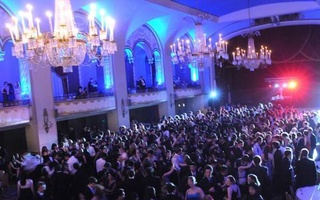A series of discoveries made this summer on Israel's Mediterranean coast by a Harvard expedition will likely dispel some widely held perceptions about the ancient Philistines.
The Hebrew Bible portrays Philistines as boorish warriors, the opposite of Israeli heroes like David and Saul. And the word "philistine" has entered into common usage to describe a person who lacks an appreciation for intellectual and aesthetic matters.
This summer's dig unearthed a different picture, however. Dorot Professor of the Archaeology of Israel Lawrence E. Stager and his team of archaeologists unearthed artifacts at Ashkelon that flatly contradict traditional assumptions about Philistine culture.
Findings of inscribed pottery, stone altars and a royal winery hinted at a new, more sophisticated image for the Philistines.
Ashkelon Arch
The most significant discovery was a mud-brick arched gateway measuring more than 12 feet high. Two other gateways had been found at other sites, but the Ashkelon arch dates to 1900 B.C.E., making it the oldest monumental arch ever found.
Stager said finding such a well-preserved arch is rare.
"The finding convinces us that the two later arched gateways were not abnormalities but continuations of the very highly developed tradition of constructing arches and vaults with mud-bricks practiced by the Canaanites and Syrians," Stager said last week.
Stager said the recovery of the gateway was one of the greatest moments of his archaeological career.
"I got a sense of the greatness of Canaanite culture in its ability to inter-display such incredible architectural technology and aesthetics in this monumental gateway," said Stager. "What we saw in Ashkelon was a small expression of the power and wealth of the Canaanites at the time."
The excavation also uncovered a warehouse, an accounting office and a complete male skeleton with a crushed skull.
"This season at Ashkelon has been the most productive one yet," said Hancock Professor of Hebrew and Other Oriental Languages Frank M. Cross, the expedition's Semitic epigraphist.
Archaeologist's Dream
The Ashkelon site, like others that fell victim to war or natural disaster, is an archaeologist's dream, Stager said.
"The destruction at Ashkelon sealed much of the material culture," said Stager. "Since things were buried instantaneously, no great erosion took place."
King Nebuchadnezzar's army sacked the site in 604 B.C.E.
Sponsored by the Harvard Semitic Museum, the Leon Levy Expedition at Ashkelon has involved nearly 100 archaeologists, specialists, professors, students and locals each summer since 1985.
Only two percent of the site, which covers more than 150 acres, has been excavated. Next summer, in its ninth season, the expedition will continue the dig to the next stratum, which dates to approximately the eighth century B.C.E.
Read more in News
OCS Administrator Makes Bid for OfficeRecommended Articles
-
Plans of Council of Federated ClubsThe Council of Federated Clubs is now in definite existence. The preliminaries of drawing up articles of agreement between the
-
Fall Exam Schedule ReleasedIt's Halloween weekend, and the last thing you want to think about is exams... but for all those non-New Englanders
-
Summer Gym ScheduleUPDATED: Want to work up a sweat during your summer months in Cambridge? Confused about which gyms are open and when? We've got you covered. Here's the finalized summer recreation schedule, at your service:
-
 Final Exam Schedule Includes Locations
Final Exam Schedule Includes Locations -
 The Voice Helps You Find a Date to Formal
The Voice Helps You Find a Date to Formal -
 Grants for Your Love
Grants for Your Love













